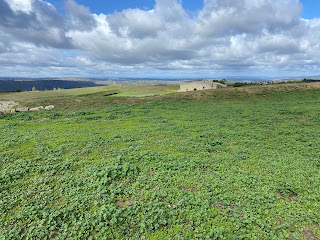Like Elvas to the south, Almeida (pop 1,300 in 2011) is a town inside a neoclassical star fortress (seventeenth century). Within these berms and bastions, the town also houses a smaller, medieval fortress (twelfth century). From the satellite images the older fortress appears to be a substantial ruin, and our experience at Marialva give us hope of finding the remains of a village.
Between Vilar Formoso and Almeida there is nothing to see. Flat lands that give the impression of being abandoned. This must be wrong though, because it is unbelievable that such vast expanses should not be cultivated. But this part of the Beiras seems deserted, perhaps because it was border land, always being invaded. (José Saramago, “Journey to Portugal,” 1990; trans Hopkinson-Caistor, 2000)
We drive north from Alfaiates, along the Spanish border, past Vilar Maior and Castelo Mendo. We park near the Porta de São Francisco, and our approach through the walls is reminiscent of our visits to other star fortress towns, like Elvas and Ciudad Rodrigo. The defensive nature of the structures and gates is readily apparent.
Almeida is its fortress. The polygonal design of the fortifications, the outline of the forts, the line of the ditches, could best be seen from the air. But even from the ground the traveller gets a good impression of the whole by walking round the walls and estimating their height. They are built for other times, other wars. People fought close to the ground, and although bombs were lobbed through the air, they were not powerful enough to destroy the arches of the gates. Those were wars of ants. Today, Almeida is as much a museum piece as a halberd or an harquebus. And the town itself, with its sober, calm air, only serves to accentuate this feeling of distance. (José Saramago, “Journey to Portugal,” 1990; trans Hopkinson-Caistor, 2000)
However, when we reach the northern heights, the medieval fortress is little more than a stone-lined ditch. Destroyed by an explosion in during the Peninsula Wars, the old castelo is picturesque in places, but now appears as a mounded lawn next to the Torre do Relógio (nineteenth century). A steel and wood walkway, in a state of disrepair, hovers over the uneven grass,
We try to make our way back to the Torre do Relógio, but the place marks in Apple Maps are mixed up; Siri leads us to the water tower, instead. There we find a man with his service van, at the locked gate of the Torre. We think he is talking to someone on his phone to get the gate open.
We walk down the hill to the town center, then circle back past the Mercado Antigo. When we reach the base of the Torre do Relógio, the man with the van is through the gate, but still barking into his mobile. We realize that he is from Vodaphone and trying to service the aerials on the top of the tower.
Next to the Torre is the gate to the Antigo Cemitério. Below the skull and cross bones, the dedication reads:
Ó tu quem quer que ésReparã como eu estouEu ja foi como tu esE tu seras como eu sou[Oh, you, whoever you areLook how I amI've already been like you areAnd you will be as I am]
As we walk among the markers, the Vodaphone tech's drone whizzes around the top of the Torre.
The northern-most bastion of the six-pointed star is labelled on our maps as 'Praça Alta', so we turn north. We find an old battery platform as well as a memorial with a kind of wreath laid against it (legible here):
JOHN BERESFORD Lieutenantin the 88th Reg received a mortal woundby the explosion of a Mine on thebreach of Ciudad Rodrigo the19th January 1812.
From the platform, we can finally make out the curtain walls and turrets along the edge of the fortress. Just below the Praça, in the neighboring star-point, a herd of sheep is mowing the grass.
Walking east toward the sheep, we find the Museu Histórico Militar, which occupies the old barracks which fills the bastion.
Just south of this is the Igreja Matriz (de Nossa Senhora do Loreto, sixteenth century). The bell tower is crowned with battlements and topped with a '3D cross'. Over the main portal, the cross and finial are wrapped in Christmas lights. In the scalloped niched on the north side, a primitive-looking Madonna and Child sit sternly, each holding an orb. The Child also holds a book with the title "ΑΩ". And in front of the Igreja, in the small courtyard, is the lean figure of a Madonna praying the rosary (possibly Nossa Senhora de Fátima).





























































No comments:
Post a Comment